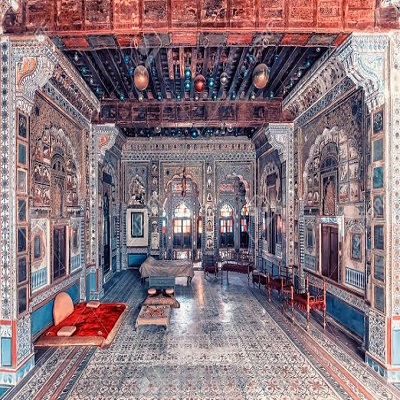
Mehrangarh Fort covers an area of 1,200 acres (486 hectares) in Jodhpur, Rajasthan, India. The complex is located on a hilltop around 122 metres above the surrounding plain, and was constructed c. 1459 by Rajput ruler Rao Jodha, though most of the existing structure is from the 17th century. Inside its boundaries there are several palaces known for their intricate carvings and expansive courtyards, as well as a museum housing various relics. A winding road leads to and from the city below. The imprints of the impact of cannonballs fired by attacking armies of Jaipur can still be seen on the second gate. At the north-east of the fort is the chhatri of Kirat Singh Soda, a soldier who fell on the spot defending Mehrangarh. There are seven gates, which include Jai Pol (meaning 'victory gate'), built by Maharaja Man Singh to commemorate his victories over the Jaipur and Bikaner armies in 1806. The Fattehpol (also meaning 'victory gate'), commemorates victory of Maharaja Ajit Singh over the Mughals. Some of the notable festivals taking place here include the World Sacred Spirit Festival and Rajasthan International Folk Festival.
Rao Jodha, the chief of the Rathore clan, is credited with the origin of Jodhpur in India. He founded Jodhpur in 1459 as the capital of Marwar (Mandore was the previous capital). He was one of Ranmal's 24 sons and became the fifteenth Rathore ruler. One year after his accession to the throne, Jodha decided to move his capital to the safer location of Jodhpur, as the one thousand years old Mandore fort was no longer considered to provide sufficient security. With the trusted aid of Rao Nara (son of Rao Samra), the Mewar forces were subdued at Mandore. With that, Rao Jodha gave Rao Nara the title of Diwan. With the help of Rao Nara, the foundation of the fort was decided on 12 May 1459